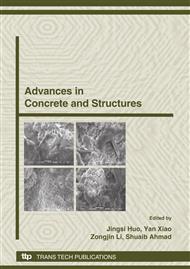p.203
p.211
p.215
p.221
p.227
p.233
p.239
p.245
p.251
Analytical Model for Corrosion Penetration Depth at Cover Cracking in RC Structures
Abstract:
Corrosion products which occupy much greater volume accumulate, and generate expansive pressures on the surrounding concrete. The pressure builds up and eventually leads to the cover cracking of the structures. The cracking accelerates further corrosion and leads to the loss of the bond strength and the load carrying capacity. Corrosion cracking would reveal the reducing of the residual service life of the corrosion-affected structures. In this paper, an analytical model is proposed to predict the critical corrosion penetration at cover cracking in RC structures based on the crack process. An attempt has been made to develop the model by considering material properties of the surrounding concrete and expansive corrosion products. The problem is established as a boundary-value problem and the governing equations are expressed in terms of the radial displacement. The analytical predictions of the proposed model have also been in agreement with the available experimental data.
Info:
Periodical:
Pages:
227-232
Citation:
Online since:
October 2008
Authors:
Keywords:
Price:
Сopyright:
© 2009 Trans Tech Publications Ltd. All Rights Reserved
Share:
Citation:


